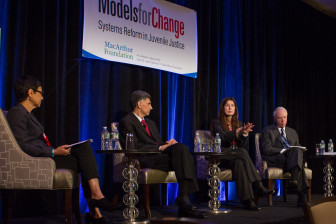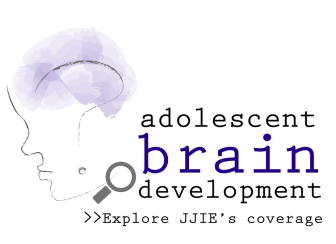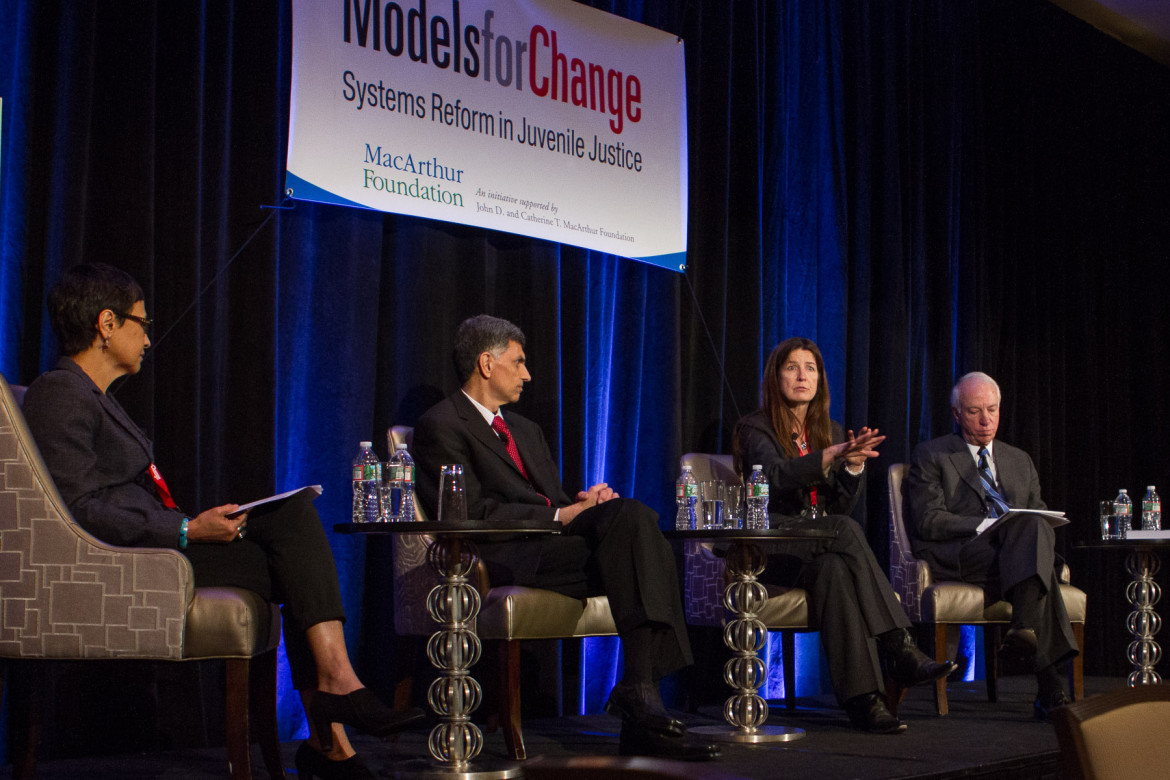
David Kindler
L to R: Laurie Garduque, director, Justice Reform, MacArthur Foundation; Fariborz Pakseresht, director, Oregon Youth Authority; BJ Casey, director, Sackler Institute for Developmental Pscychobiology, Cornell University; and Richard Bonnie, director, Institute of Law, Psychiatry and Public Policy, University of Virginia.
WASHINGTON – Adolescent brain development should play a greater role in determining how youths are treated in the juvenile justice system, experts said at a national juvenile justice conference Monday.
The experts appeared on a panel at the John D. and Catherine T. MacArthur Foundation’s eighth annual Models for Change National Working Conference.
Neuroscientist BJ Casey, director of the Sackler Institute at the Weill Cornell Medical College, pointed out on a slide images of areas of a brain that are developing from around age 5 to around age 20.
“These are the very regions that are important for planning, making decisions, regulating behavior that are continuing to develop during this time,” Casey said.
“There are also changes in big structures in the brain that are associated with desire and fight and flight, and really what we’re seeing is as these regions are maturing, they’re activated because of changes in hormones and chemicals and fine-tuning of the circuitry.”
Adolescent brain development has played an increasingly important role in juvenile justice.
 In recent years, for example, the Supreme Court has noted in key decisions that juveniles’ brains are not fully developed, and youths are more susceptible than adults to peer pressure, more impulsive, more likely to take risks, less likely to consider long-term consequences and more amenable to rehabilitation.
In recent years, for example, the Supreme Court has noted in key decisions that juveniles’ brains are not fully developed, and youths are more susceptible than adults to peer pressure, more impulsive, more likely to take risks, less likely to consider long-term consequences and more amenable to rehabilitation.
But Casey emphasized that adolescent brain development doesn’t occur in a vacuum.
“I don’t want you to think that brain maturation occurs in isolation,” she said. “It doesn’t. It’s all about the brain adapting to its environment and developing based on the experiences that the individual has.
“And if you’re going to reach full adulthood … it’s a transient period where the child is learning how to be more reliant on himself in making judgments and decisions as opposed to parents. And without the opportunities and reinforcement of appropriate behaviors, they’ll really have difficulty in transitioning into that role.”
Panelist Richard Bonnie, director of the Institute of Law, Psychiatry and Public Policy at the University of Virginia, spoke of a 2012 National Research Council report he co-authored that concluded the treatment of juvenile offenders should reflect knowledge about adolescent brain development.
Panel facilitator Laurie Garduque, director of the Justice Reform Program at the MacArthur Foundation, said the NRC report reaffirmed some notions of the U.S. juvenile justice system dating to its origins in the 1890s, then asked Bonnie what the report had brought to the field.
“Our current thinking is rooted scientifically in a different set of ideas,” Bonnie said. “I do think that the understanding that we now have of adolescent development is profoundly different.”
He took issue with some observers, including some Supreme Court justices, who “say we’ve known for centuries … that kids are different from adults and implicitly, of course, that adolescents [are] in particular.”
But, Bonnie added, “Now we have that kind of scientific foundation to think about the juvenile justice system and its practices and policies in a way that people did not have before.”
He noted that in the Supreme Court’s 1967 Gault decision, guaranteeing juveniles many of the same due process rights granted to adults, “one of the criticisms of the juvenile justice system … was that we had not delivered on the promise, the rehabilitative ideals and the promise of prevention and instead had fallen into punishment in fact, if not in law.”
Bonnie pointed out the NRC report had stressed the need for accountability and fairness in dealing with juveniles that takes into account adolescent development.
“It embraces fairness [and] accountability so accountability is not just some alternative word to use for smuggling punishment into the juvenile justice system but a way of understanding in holding a young person accountable for their behavior, to teach responsibility and promote successful law-abiding behavior as adults,” Bonnie said.
He also said adolescents are “hyper-sensitive” to whether they’re being treated fairly – as “it’s part of the developmental process” – and called on everyone in the juvenile justice system to treat them fairly.
“It’s important in terms of adolescent development … to see that treating kids fairly is part of the reciprocal obligation that we are trying to teach, which is that you are responsible for your behavior and it’s important for you to recognize that you’re going to be held accountable for it if you’ve done it, but it’s also important for us to treat them fairly, you know, in that way and in every other way and that that needs to be infused throughout the practice of the juvenile justice system in terms of every interaction so it’s not just a matter of theory.”
Fairborz Pakseresht, director of the Oregon Youth Authority, brought to the panel the perspective of a juvenile justice administrator overseeing the OYA, the state’s juvenile justice agency.
Pakseresht, who took over as OYA director last year, said the juvenile justice system must adapt to advances in knowledge about adolescent development and base policies on research and data.
“Clearly, the challenge that we have is that we are emerging from a system that is based in old thinking,” he said.
He continued: “You know, in the current mold, we think that you commit X crime and you get X number of years or months. And the question becomes is that the best way of dealing with our youth? And the biggest challenge is changing our whole mindset and changing the function within our system, within our facilities etc.”
He said youths in the juvenile justice system can also be seen as victims.
“What we need to do in our part of the system, particularly in the deep end of the system, is not victimize them and further traumatize them. They’re going to become our neighbors. They’re going to live in our communities. Are we placing the youth in the right environment?”
Pakseresht said statistics showed that for youths moved from the juvenile system to the adult Division of Corrections in Oregon because of behavior, recidivism increased by 136 percent among those youth.
When he received a list of six youths who personnel in the facility believed should be transferred to the DOC, Pakseresht denied the requests.
“The governor did not hire me to send them to DOC,” he said. “I am here to create better outcomes for communities, and we have to do the best for them.”


Pingback: Panel Believes Brain Development Should Seriously Influence the Treatment of Juvenile Offenders | Humane Exposures Blog
Thank goodness we now have some hard science that will perhaps turn back the tide on the barbaric and socially backward US practice of treating children and teenagers who commit crimes as fully-functioning and responsible adults. The dearth of understanding and sensitivity to developmental issues in the “juvenile” justice system is quite appalling. Even when judges have insight their hands are too often tied because of a sorry lack of rehabilitative resources. If half as much money were put into expanding the number of rehabilitative and humane juvenile detention facilities as is invested in prosecuting children as adults, society would have a much less bleak future.
We need to pick out the seeds from the bad apples and replant them rather than just toss out the whole fruit onto the garbage dump.
Poor Little Rich Boy, Better Beware…..
http://babelbooth.com/2013/12/17/poor-little-rich-boy-better-beware/